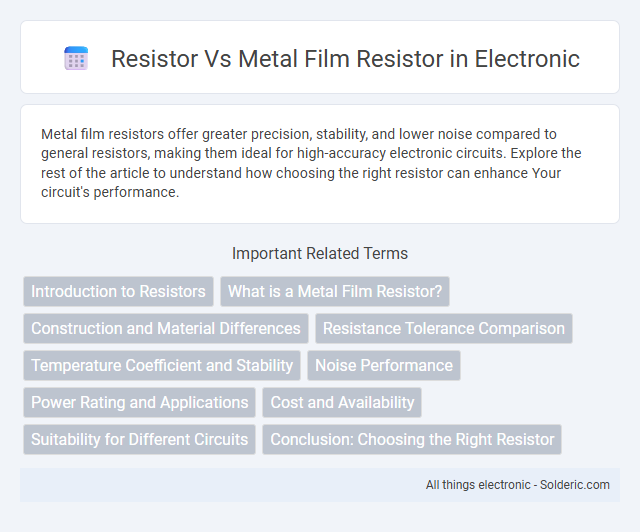Metal film resistors offer greater precision, stability, and lower noise compared to general resistors, making them ideal for high-accuracy electronic circuits. Explore the rest of the article to understand how choosing the right resistor can enhance Your circuit's performance.
Comparison Table
| Feature | Resistor | Metal Film Resistor |
|---|---|---|
| Construction | Carbon composition or wire-wound | Thin metal film deposited on ceramic core |
| Tolerance | +-5% to +-20% | +-1% to +-2% |
| Temperature Coefficient | High, varies with type | Low, typically +-50 ppm/degC |
| Noise | Higher noise levels | Low noise performance |
| Stability | Moderate, degrades over time | High stability, long-term reliability |
| Power Rating | Varies widely (1/4W to several watts) | Typically 1/4W to 1W |
| Application | General purpose, cost-effective | Precision circuits, audio, instrumentation |
| Cost | Lower cost | Higher cost due to precision |
Introduction to Resistors
Resistors regulate electrical current by offering a specific amount of resistance within circuits, ensuring stable voltage and current distribution. Metal film resistors, a subtype of resistors, provide superior accuracy, lower noise, and improved temperature stability compared to standard carbon composition resistors. Choosing metal film resistors can enhance the reliability and performance of your electronic projects due to their precise resistance values and durability.
What is a Metal Film Resistor?
A metal film resistor is a type of resistor that uses a thin layer of metal deposited on a ceramic substrate to provide precise resistance values with low noise and high stability. Compared to standard carbon resistors, metal film resistors offer improved accuracy, better temperature coefficient, and reduced tolerance variations. When designing your circuits, choosing metal film resistors ensures enhanced reliability and consistent performance under varying environmental conditions.
Construction and Material Differences
Metal film resistors feature a thin metal coating on a ceramic core, offering superior stability and precision compared to traditional carbon composition resistors made from a mixture of carbon and binder materials. The metal film construction reduces noise and temperature coefficient variations, ensuring more reliable performance in sensitive electronic circuits. Your design benefits from metal film resistors' enhanced durability and tighter tolerance levels, making them ideal for applications requiring high accuracy.
Resistance Tolerance Comparison
Metal film resistors typically offer tighter resistance tolerance, commonly within +-1% to +-0.5%, compared to standard carbon film resistors, which often have tolerances around +-5%. The improved manufacturing precision of metal film resistors results in more stable and predictable resistance values, enhancing circuit accuracy and performance. For applications requiring high accuracy and reliability, metal film resistors are the preferred choice due to their superior resistance tolerance characteristics.
Temperature Coefficient and Stability
Metal film resistors exhibit significantly lower temperature coefficients, often around 50 ppm/degC or less, compared to standard carbon resistors which can exceed 200 ppm/degC, enhancing their precision in temperature-sensitive applications. Their stability over time is superior due to the uniform metal oxide film, resulting in minimal drift and improved reliability under varying environmental conditions. These characteristics make metal film resistors preferable in circuits requiring high accuracy and long-term performance consistency.
Noise Performance
Metal film resistors exhibit significantly lower noise levels compared to standard carbon film resistors due to their uniform structure and high purity materials. The reduced excess noise and thermal noise in metal film resistors improve the overall signal integrity in sensitive electronic circuits. Choosing a metal film resistor enhances your circuit's precision by minimizing noise-induced errors.
Power Rating and Applications
Metal film resistors typically offer higher power ratings and improved tolerance compared to standard carbon film resistors, making them better suited for precision applications requiring stable performance under varying loads. Their low noise and temperature coefficient enable reliable operation in audio equipment, instrumentation, and high-frequency circuits. Choosing the appropriate resistor depends on your circuit's power requirements and the need for accuracy or noise reduction.
Cost and Availability
Metal film resistors typically cost more than standard carbon resistors due to their superior precision and lower noise characteristics, making them a preferred choice for high-performance applications. Standard resistors are widely available and more cost-effective for general-purpose use, offering a balance between affordability and functionality. Your selection depends on budget constraints and the need for accuracy, with metal film resistors commanding higher prices but better stability in demanding circuits.
Suitability for Different Circuits
Metal film resistors offer superior precision and stability, making them ideal for high-frequency and low-noise circuits such as audio equipment and measurement devices. Standard carbon composition resistors are more suitable for general-purpose applications where cost is a priority and exact resistance values are less critical. Your choice between these depends on circuit requirements for accuracy, noise tolerance, and environmental conditions.
Conclusion: Choosing the Right Resistor
Metal film resistors offer superior precision, stability, and low noise compared to general carbon resistors, making them ideal for applications requiring accurate and consistent resistance values. Your choice should consider the tolerance level, temperature coefficient, and frequency response to ensure optimal circuit performance. Selecting metal film resistors enhances reliability in sensitive electronic designs where resistor stability and noise performance are critical.
resistor vs metal film resistor Infographic

 solderic.com
solderic.com